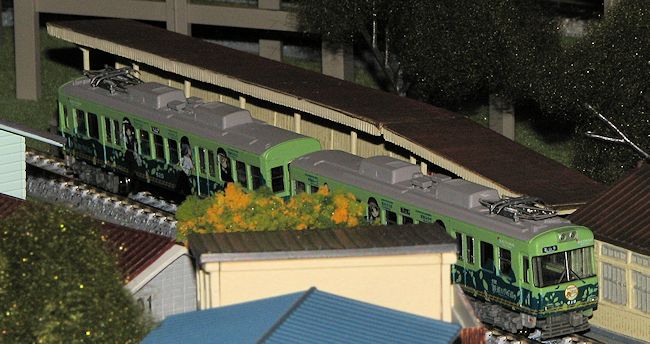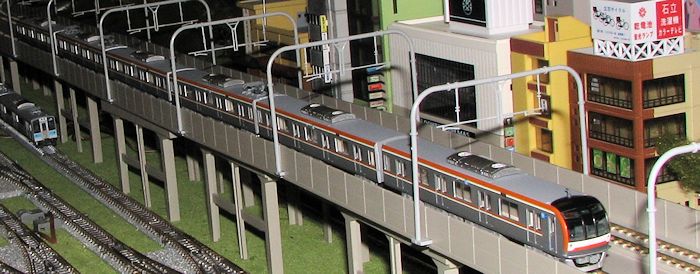Let me start off this edition by covering another aspect of Japanese trains.
Like their busses, Tomytec produces a wide line of trains and trolleys. Like
their busses, these are display or collectors models, but also like their
busses, they can be powered for use on the rails. These are either one or two
car trains and trolleys, subjects that the 'big boys' would be unlikely to add
to their powered catalogs, but are sold in large enough numbers for the
display/collector market.
Powering them is a pretty simple task as there are a number of easily
installed motorized chassis in various sizes to fit these trains. Often when one
buys one of these trains, there will be a listing of the parts needed to upgrade
it to being powered. In the listing will not only be the motorized chassis for
one of the cars, but also replacement metal pantographs and upgraded wheels and
weights needed for the second car. If there is a downside to these installations
it is that there are no headlights nor interior light kits available. To have
these function there would need to be a way to transfer power from the wheels
into the chassis to where one could install lights, but that hasn't become a
reality as of yet.
As mentioned, these vehicles are from some of the smaller and less densely
travelled lines. Unlike the US, trains are often the only way most people can
get around so even in less populous areas, train lines are kept operating.
 So far, I've upgraded
several of these trains. The base train is actually pretty
inexpensive, often retailing in Japan for $20 or less. Then one adds the
motorized chassis for around $20-25, a set to replace the wheels and couplers
for the second car (and this set is good for two cars so can be used on future
projects) for about $8, and if needed, some metal functional pantographs for
about $5. Total for this operation is around $50. Assuming that any major
manufacturer like Kato or MicroAce produced this set, it would run about $80.
So far, I've upgraded
several of these trains. The base train is actually pretty
inexpensive, often retailing in Japan for $20 or less. Then one adds the
motorized chassis for around $20-25, a set to replace the wheels and couplers
for the second car (and this set is good for two cars so can be used on future
projects) for about $8, and if needed, some metal functional pantographs for
about $5. Total for this operation is around $50. Assuming that any major
manufacturer like Kato or MicroAce produced this set, it would run about $80.
Those that I've done up to now are a small train from the
Keihan
Ishiyama-Sakamoto Line (above) and a pair from the
Wakayama Electric Railways
Kishigawa Line (below). The Keihan Railway's train is
 decorated with figures dressed
in various railway line uniforms, which is different. Actually decorating
smaller line's trains with anime figures is not all that uncommon. The red train
is one of three special trains on the Kishigawa Line. In this case it is the red 'Omocha'
train. Omocha is Japanese for toys and in addition to having them throughout the
inside of the train, the train has vending machines from which you
decorated with figures dressed
in various railway line uniforms, which is different. Actually decorating
smaller line's trains with anime figures is not all that uncommon. The red train
is one of three special trains on the Kishigawa Line. In this case it is the red 'Omocha'
train. Omocha is Japanese for toys and in addition to having them throughout the
inside of the train, the train has vending machines from which you can purchase
small toys as souvenirs. Believe it or not, a cat brought this railway from the
precipice of bankruptcy to full solvency. It is one of those 'only in Japan'
stories and quite interesting as well. Read about it
here.
In addition to the 'toys' train, I was also able to get the Tamaden version
(Tama's train), which I find a lot more interesting!
can purchase
small toys as souvenirs. Believe it or not, a cat brought this railway from the
precipice of bankruptcy to full solvency. It is one of those 'only in Japan'
stories and quite interesting as well. Read about it
here.
In addition to the 'toys' train, I was also able to get the Tamaden version
(Tama's train), which I find a lot more interesting!
 Another motorized Tomytec display model is the nice yellow pair of type 200
trains of the
Isumi (or Izumi)
Railway. These are designed to operate as single car trains, but are
frequently paired. Like most Japanese commuter type trains, they are not speed
demons with an operating speed of around 40 mph (65 kph). In line with the other
conversion trains, this one runs on the inner loop. Unlike others, this is a
diesel powered train, so no need for overhead wires and thus, no pantograph.
Another motorized Tomytec display model is the nice yellow pair of type 200
trains of the
Isumi (or Izumi)
Railway. These are designed to operate as single car trains, but are
frequently paired. Like most Japanese commuter type trains, they are not speed
demons with an operating speed of around 40 mph (65 kph). In line with the other
conversion trains, this one runs on the inner loop. Unlike others, this is a
diesel powered train, so no need for overhead wires and thus, no pantograph.
 Of course, it doesn't
mean I have stopped adding standard trains, and one nice one is a
Fukutoshin
Line set from Kato. This is part of the Tokyo Metro system and runs on the
west and northwest side of the area. So far, I've only gotten the initial
six cars. This set was previously offered by MicroAce, but the Kato set is less
expensive and, in my opinion, a better quality.
Of course, it doesn't
mean I have stopped adding standard trains, and one nice one is a
Fukutoshin
Line set from Kato. This is part of the Tokyo Metro system and runs on the
west and northwest side of the area. So far, I've only gotten the initial
six cars. This set was previously offered by MicroAce, but the Kato set is less
expensive and, in my opinion, a better quality.
I am still adding a building or two every now and
then, but this is almost at an end as I've used most of the available space
already.
Back to Silver Rails index
 So far, I've upgraded
several of these trains. The base train is actually pretty
inexpensive, often retailing in Japan for $20 or less. Then one adds the
motorized chassis for around $20-25, a set to replace the wheels and couplers
for the second car (and this set is good for two cars so can be used on future
projects) for about $8, and if needed, some metal functional pantographs for
about $5. Total for this operation is around $50. Assuming that any major
manufacturer like Kato or MicroAce produced this set, it would run about $80.
So far, I've upgraded
several of these trains. The base train is actually pretty
inexpensive, often retailing in Japan for $20 or less. Then one adds the
motorized chassis for around $20-25, a set to replace the wheels and couplers
for the second car (and this set is good for two cars so can be used on future
projects) for about $8, and if needed, some metal functional pantographs for
about $5. Total for this operation is around $50. Assuming that any major
manufacturer like Kato or MicroAce produced this set, it would run about $80.



 Of course, it doesn't
mean I have stopped adding standard trains, and one nice one is a
Of course, it doesn't
mean I have stopped adding standard trains, and one nice one is a